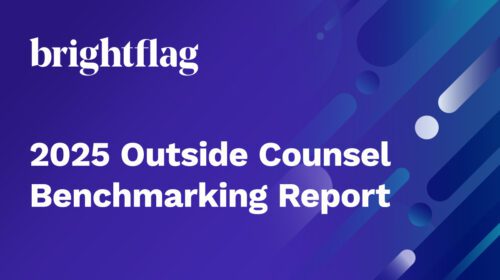How to Conduct an Effective Law Firm Panel Review
Selecting and maintaining a high-performing panel of outside counsel is a great way for in-house legal departments to keep costs under control and optimize legal service delivery. Think of a panel review like tending a garden: regular pruning and attention ensure better outcomes. Without it, weeds of inefficiency and inflated costs quickly take root.
In this guide, we’ll walk through why panel reviews matter, how to conduct them effectively, and how Brightflag’s technology streamlines the process.
Why Review Your Law Firm Panel?
Law firm panel reviews are not just administrative exercises; they are strategic initiatives that provide opportunities to:
- Consolidate work and secure value-add services: Working with fewer, trusted firms can yield better volume discounts and complementary benefits like training, secondments, and advisory consultations.
- Ensure competitive rates: The rates and discounts you receive from outside counsel need periodic benchmarking to ensure they align with current industry norms.
- Prioritize quality: A review enables you to double down on your best-performing partners and phase out underperformers.
- Streamline engagements: Clear panel structures help your team know exactly which firm to turn to for specific matters, saving valuable time.
Without regular law firm panel reviews, inefficiencies in service delivery, cost management, and firm alignment can go unnoticed. Proactive panel management ensures you are consistently working with the firms best equipped to support your department’s evolving legal needs.
How to Conduct a Panel Review
1. Assemble an Internal Review Team and Set Objectives
Form a small, cross-functional committee that includes key stakeholders, such as representatives from legal operations, finance, and senior legal leadership.
Defining clear objectives is critical: Are you focused on reducing legal spend, ensuring alignment with your business goals, or elevating client service standards?
Clarifying these focus areas from the beginning will help ensure that the panel review process stays targeted, strategic, and aligned with your organization’s broader business needs.
2. Analyze Your Current Law Firm Panel
Before considering new providers, start by thoroughly evaluating your existing outside counsel relationships.
Use your e-billing and matter management platform to generate the critical insights you need into areas like:
- Volume: Which firms are handling the largest share of your legal work? Is the work concentrated among a few firms, or spread across many vendors?
- Practice Area Overlap: Identify redundancy. How many firm relationships does your team have? How many of those firms are delivering similar types of work, and where could consolidation improve efficiency?
- Cost Analysis: Assess your discounts, hourly rates, and average matter costs by work type. This can help identify cost-saving opportunities.
- Performance Evaluation: Leverage qualitative surveys, such as the post-matter survey triggered in Brightflag, to assess firms across essential dimensions like communication, work quality, business alignment, budget management, and likelihood to recommend.
This comprehensive assessment will reveal where your firms excel, so you can double down on those strengths, and where there is room for improvement that the new panel structure can address.
As Jeff Barlow, General Counsel of Momentive Technologies, shared during a recent Brightflag webinar: “It’s tough to run an RFP if you don’t have the data at your fingertips.” Having this foundation in place ensures your law firm panel review is based on facts, not assumptions.
3. Send Clear and Strategic RFPs
If you decide to re-open spots on your panel or bring in new firms, your Request for Proposal (RFP) process is your chance to set expectations.
To optimize RFP responses:
- Clearly articulate your needs, billing requirements, and desired value-add services. Use the inputs from your evaluation of your existing panel to drive this: what does great look like today? And what practices do you want to leave in the past?
- Set strict word limits for submissions to ensure concise, comparable proposals.
- Consider a phased RFP approach, starting with your highest-spend or most strategic practice areas. This helps make the RFP process less overwhelming while tackling the most important areas first.
RFPs should also ask firms to agree upfront to key commercial terms, such as your outside counsel guidelines, annual rate increase policies, and diversity commitments.
4. Evaluate Responses and Select Your Panel
Review RFP submissions systematically, balancing quantitative data (rates, discounts, staffing structures) and qualitative factors (cultural fit, client service philosophy, innovation capabilities).
This is also the time to reinforce compliance expectations:
- Adherence to your outside counsel guidelines
- Billing hygiene (e.g. no block billing, timely invoicing)
- Participation in regular business reviews
A panel agreement outlining mutual commitments can formalize the relationship.

5. Monitor Panel Performance
Panel governance doesn’t stop after selection. Ongoing performance monitoring is vital to maintaining high standards.
Using a platform like Brightflag, you can:
- Track adherence to agreed rates, resourcing plans, and discounts.
- Assess matter outcomes relative to budgets and timelines.
- Gather post-matter feedback to assess relationship health.
- Enforce billing guidelines and flag non-compliance automatically.
Effective panel management transforms the panel review process into a continuous improvement cycle.
Why E-Billing Is Essential for Law Firm Panel Reviews
Modern panel reviews demand easy access to data, and that’s why e-billing platforms like Brightflag are indispensable. Real-time, centralized data enables legal teams to:
- Establish Baselines: Understand your current rates, discount levels, and matter costs with precision.
- Identify Opportunities: Spot areas for consolidation, improvement, or renegotiation based on historical trends.
- Ensure Compliance: Monitor firm adherence to agreed financial terms, billing guidelines, and resourcing expectations.
As Steve Cummins, Head of Panel Management at AIB, put it: “If you have a system like Brightflag in place, you already have a wealth of data about your firms that you can leverage during your panel review. You can use this to identify the areas most in need of improvement, so firms know what’s most important to you during panel selection.”
By tapping into the intelligence already available through platforms like Brightflag, you set yourself up for a smarter, more strategic panel review—one grounded in real performance metrics.
How Brightflag AI Supercharges Law Firm Panel Reviews
Brightflag’s AI-powered platform dramatically improves every stage of the panel review process. It reviews every invoice and matter automatically, ensuring that you have consistent data with which to assess your panel. Using Brightflag AI to power your panel review process brings the following benefits:
- Comprehensive Data: Analyze firm performance across efficiency, billing hygiene, resourcing, and quality metrics.
- Streamlined Compliance: Automatically detect non-compliant billing practices, rate violations, and adherence to outside counsel guidelines.
- Performance Benchmarking: Compare firms against each other and industry norms with built-in benchmarking tools.
- Insights at Scale: Quickly identify your highest-value firms and areas where changes could yield immediate returns.
With Brightflag, legal operations teams can transform panel management from a reactive administrative task into a strategic driver of value.

Best Practices for Ongoing Panel Management
Effective panel management doesn’t end with a successful review. To maximize the value of your outside counsel panel:
- Hold Regular Business Reviews: Conduct quarterly or semi-annual meetings to discuss performance, upcoming needs, and continuous improvement opportunities.
- Implement Scorecards: Use standardized scorecards measuring key KPIs like budget adherence, quality, communication, and responsiveness.
- Track Diversity and Innovation: Monitor whether firms are meeting diversity commitments and providing innovation around service delivery, particularly around the use of AI.
- Reinforce Panel Discipline: Ensure new matters are assigned within the panel unless there’s a compelling reason to go outside.
Establishing clear, data-backed expectations and maintaining active dialogue with your panel firms builds stronger partnerships and better outcomes.
Conclusion
Just like a thriving garden needs regular tending, your outside counsel panel requires careful management to deliver the highest value. Conducting a strategic panel review is your opportunity to ensure your department is working with the right partners at the right pricing—and that expectations around quality, service, and innovation are clear and enforced.
By leveraging e-billing technology and AI-powered insights from Brightflag, GCs and legal ops leaders can create high-performing panels that support legal’s role as a strategic enabler of business goals.
Ready to streamline your panel review process and drive more cost-effectiveness from your outside counsel? Learn more about how Brightflag can help.



